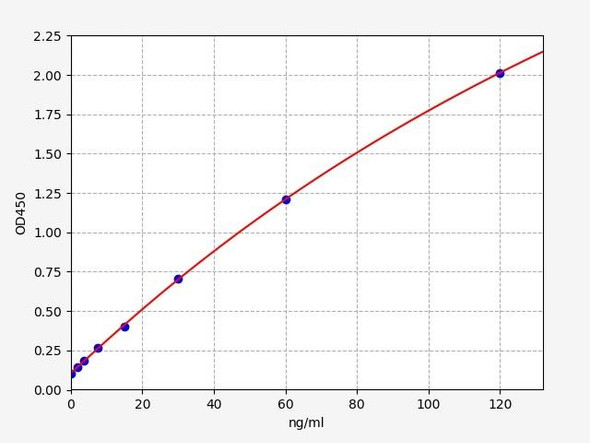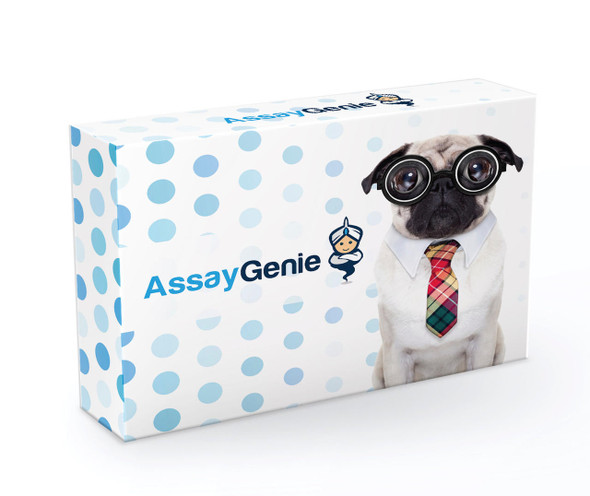Mouse ELISA Kits
Mouse Epidermal growth factor receptor (Egfr) ELISA Kit
- SKU:
- MOEB0577
- Product Type:
- ELISA Kit
- Size:
- 96 Assays
- Uniprot:
- Q01279
- Range:
- 78-5000 pg/ml
- ELISA Type:
- Sandwich
- Synonyms:
- EGFR, ErbB-1, ErbB1, ERBB, HER1, Mena
- Reactivity:
- Mouse
Description
| Product Name: | Mouse Epidermal growth factor receptor (Egfr) ELISA Kit |
| Product Code: | MOEB0577 |
| Alias: | Epidermal growth factor receptor, Egfr, 2.7.10.1 |
| Uniprot: | Q01279 |
| Reactivity: | Mouse |
| Range: | 78-5000 pg/ml |
| Detection Method: | Sandwich |
| Size: | 96 Assay |
| Storage: | Please see kit components below for exact storage details |
| Note: | For research use only |
| UniProt Protein Function: | EGFR: a receptor tyrosine kinase. This is a receptor for epidermal growth factor (EGF) and related growth factors including TGF-alpha, amphiregulin, betacellulin, heparin-binding EGF-like growth factor, GP30, and vaccinia virus growth factor. EGFR is involved in the control of cell growth and differentiation. It is a single-pass transmembrane tyrosine kinase. Ligand binding to this receptor results in receptor dimerization, autophosphorylation (in trans), activation of various downstream signaling molecules and lysosomal degradation. It can be phosphorylated and activated by Src. Activated EGFR binds the SH2 domain of phospholipase C-gamma (PLC-gamma), activating PLC-gamma-mediated downstream signaling. Phosphorylated EGFR binds Cbl, leading to its ubiquitination and degradation. Grb2 and SHC bind to phospho-EGFR and are involved in the activation of MAP kinase signaling pathways. Phosphorylation on Ser and Thr residues is thought to represent a mechanism for attenuation of EGFR kinase activity. EGFR is overexpressed in breast, head and neck cancers, correlating with poor survival. Activating somatic mutations are seen in lung cancer, corresponding to the minority of patients with strong responses to the EGFR inhibitor Iressa (gefitinib). Mutations and amplifications are also seen in glioblastoma, and upregulation is seen in colon cancer and neoplasms. In xenografts, inhibitors synergize with cytotoxic drugs in the inhibition of many tumor types. Inhibitors include: Iressa/ZD1839, Erbitux, Tarceva, and lapatinib. Four alternatively spliced isoforms have been described. |
| UniProt Protein Details: | Protein type:EC 2.7.10.1; EGFR family; Kinase, protein; Membrane protein, integral; Protein kinase, TK; Protein kinase, tyrosine (receptor); TK group; Tumor suppressor Chromosomal Location of Human Ortholog: 11 A2|11 9.41 cM Cellular Component: apical plasma membrane; basolateral plasma membrane; cell surface; cytoplasm; early endosome membrane; endocytic vesicle; endosome; endosome membrane; focal adhesion; intracellular; lipid raft; membrane; nucleus; perinuclear region of cytoplasm; plasma membrane; receptor complex; synapse Molecular Function:actin filament binding; cadherin binding; calmodulin binding; chromatin binding; enzyme binding; epidermal growth factor binding; epidermal growth factor receptor activity; glycoprotein binding; identical protein binding; integrin binding; kinase activity; nitric-oxide synthase regulator activity; protein binding; protein heterodimerization activity; protein kinase binding; protein phosphatase binding; protein-tyrosine kinase activity; receptor binding; signal transducer activity; transmembrane receptor activity; ubiquitin protein ligase binding Biological Process: activation of MAPKK activity; astrocyte activation; cell morphogenesis; cell proliferation; cell surface receptor linked signal transduction; cell-cell adhesion; cerebral cortex cell migration; digestive tract morphogenesis; embryonic placenta development; epidermal growth factor receptor signaling pathway; epidermis development; G1/S-specific positive regulation of cyclin-dependent protein kinase activity; hair follicle development; learning and/or memory; negative regulation of apoptosis; negative regulation of mitotic cell cycle; negative regulation of protein catabolic process; neurite morphogenesis; ovulation cycle; peptidyl-tyrosine phosphorylation; positive regulation of bone resorption; positive regulation of cell growth; positive regulation of cell migration; positive regulation of cell proliferation; positive regulation of DNA repair; positive regulation of DNA replication; positive regulation of epithelial cell proliferation; positive regulation of fibroblast proliferation; positive regulation of inflammatory response; positive regulation of MAP kinase activity; positive regulation of nitric oxide biosynthetic process; positive regulation of phosphorylation; positive regulation of protein amino acid phosphorylation; positive regulation of protein kinase B signaling cascade; positive regulation of smooth muscle cell proliferation; positive regulation of superoxide release; positive regulation of synaptic transmission, glutamatergic; positive regulation of transcription from RNA polymerase II promoter; positive regulation of transcription, DNA-dependent; positive regulation of vasoconstriction; protein amino acid autophosphorylation; receptor-mediated endocytosis; regulation of cell proliferation; regulation of JNK cascade; regulation of nitric-oxide synthase activity; regulation of peptidyl-tyrosine phosphorylation; regulation of phosphoinositide 3-kinase cascade; response to calcium ion; salivary gland morphogenesis; signal transduction; translation; wound healing |
| UniProt Code: | Q01279 |
| NCBI GenInfo Identifier: | 1352359 |
| NCBI Gene ID: | 13649 |
| NCBI Accession: | Q01279.1 |
| UniProt Related Accession: | Q01279 |
| Molecular Weight: | 134,853 Da |
| NCBI Full Name: | Epidermal growth factor receptor |
| NCBI Synonym Full Names: | epidermal growth factor receptor |
| NCBI Official Symbol: | Egfr |
| NCBI Official Synonym Symbols: | Wa5; wa2; Erbb; Errp; wa-2; Errb1; AI552599; 9030024J15Rik |
| NCBI Protein Information: | epidermal growth factor receptor |
| UniProt Protein Name: | Epidermal growth factor receptor |
| Protein Family: | Epidermal growth factor receptor |
| UniProt Gene Name: | Egfr |
| Component | Quantity (96 Assays) | Storage |
| ELISA Microplate (Dismountable) | 8×12 strips | -20°C |
| Lyophilized Standard | 2 | -20°C |
| Sample Diluent | 20ml | -20°C |
| Assay Diluent A | 10mL | -20°C |
| Assay Diluent B | 10mL | -20°C |
| Detection Reagent A | 120µL | -20°C |
| Detection Reagent B | 120µL | -20°C |
| Wash Buffer | 30mL | 4°C |
| Substrate | 10mL | 4°C |
| Stop Solution | 10mL | 4°C |
| Plate Sealer | 5 | - |
Other materials and equipment required:
- Microplate reader with 450 nm wavelength filter
- Multichannel Pipette, Pipette, microcentrifuge tubes and disposable pipette tips
- Incubator
- Deionized or distilled water
- Absorbent paper
- Buffer resevoir
*Note: The below protocol is a sample protocol. Protocols are specific to each batch/lot. For the correct instructions please follow the protocol included in your kit.
Allow all reagents to reach room temperature (Please do not dissolve the reagents at 37°C directly). All the reagents should be mixed thoroughly by gently swirling before pipetting. Avoid foaming. Keep appropriate numbers of strips for 1 experiment and remove extra strips from microtiter plate. Removed strips should be resealed and stored at -20°C until the kits expiry date. Prepare all reagents, working standards and samples as directed in the previous sections. Please predict the concentration before assaying. If values for these are not within the range of the standard curve, users must determine the optimal sample dilutions for their experiments. We recommend running all samples in duplicate.
| Step | |
| 1. | Add Sample: Add 100µL of Standard, Blank, or Sample per well. The blank well is added with Sample diluent. Solutions are added to the bottom of micro ELISA plate well, avoid inside wall touching and foaming as possible. Mix it gently. Cover the plate with sealer we provided. Incubate for 120 minutes at 37°C. |
| 2. | Remove the liquid from each well, don't wash. Add 100µL of Detection Reagent A working solution to each well. Cover with the Plate sealer. Gently tap the plate to ensure thorough mixing. Incubate for 1 hour at 37°C. Note: if Detection Reagent A appears cloudy warm to room temperature until solution is uniform. |
| 3. | Aspirate each well and wash, repeating the process three times. Wash by filling each well with Wash Buffer (approximately 400µL) (a squirt bottle, multi-channel pipette,manifold dispenser or automated washer are needed). Complete removal of liquid at each step is essential. After the last wash, completely remove remaining Wash Buffer by aspirating or decanting. Invert the plate and pat it against thick clean absorbent paper. |
| 4. | Add 100µL of Detection Reagent B working solution to each well. Cover with the Plate sealer. Incubate for 60 minutes at 37°C. |
| 5. | Repeat the wash process for five times as conducted in step 3. |
| 6. | Add 90µL of Substrate Solution to each well. Cover with a new Plate sealer and incubate for 10-20 minutes at 37°C. Protect the plate from light. The reaction time can be shortened or extended according to the actual color change, but this should not exceed more than 30 minutes. When apparent gradient appears in standard wells, user should terminatethe reaction. |
| 7. | Add 50µL of Stop Solution to each well. If color change does not appear uniform, gently tap the plate to ensure thorough mixing. |
| 8. | Determine the optical density (OD value) of each well at once, using a micro-plate reader set to 450 nm. User should open the micro-plate reader in advance, preheat the instrument, and set the testing parameters. |
| 9. | After experiment, store all reagents according to the specified storage temperature respectively until their expiry. |
When carrying out an ELISA assay it is important to prepare your samples in order to achieve the best possible results. Below we have a list of procedures for the preparation of samples for different sample types.
| Sample Type | Protocol |
| Serum | If using serum separator tubes, allow samples to clot for 30 minutes at room temperature. Centrifuge for 10 minutes at 1,000x g. Collect the serum fraction and assay promptly or aliquot and store the samples at -80°C. Avoid multiple freeze-thaw cycles. If serum separator tubes are not being used, allow samples to clot overnight at 2-8°C. Centrifuge for 10 minutes at 1,000x g. Remove serum and assay promptly or aliquot and store the samples at -80°C. Avoid multiple freeze-thaw cycles. |
| Plasma | Collect plasma using EDTA or heparin as an anticoagulant. Centrifuge samples at 4°C for 15 mins at 1000 × g within 30 mins of collection. Collect the plasma fraction and assay promptly or aliquot and store the samples at -80°C. Avoid multiple freeze-thaw cycles. Note: Over haemolysed samples are not suitable for use with this kit. |
| Urine & Cerebrospinal Fluid | Collect the urine (mid-stream) in a sterile container, centrifuge for 20 mins at 2000-3000 rpm. Remove supernatant and assay immediately. If any precipitation is detected, repeat the centrifugation step. A similar protocol can be used for cerebrospinal fluid. |
| Cell culture supernatant | Collect the cell culture media by pipette, followed by centrifugation at 4°C for 20 mins at 1500 rpm. Collect the clear supernatant and assay immediately. |
| Cell lysates | Solubilize cells in lysis buffer and allow to sit on ice for 30 minutes. Centrifuge tubes at 14,000 x g for 5 minutes to remove insoluble material. Aliquot the supernatant into a new tube and discard the remaining whole cell extract. Quantify total protein concentration using a total protein assay. Assay immediately or aliquot and store at ≤ -20 °C. |
| Tissue homogenates | The preparation of tissue homogenates will vary depending upon tissue type. Rinse tissue with 1X PBS to remove excess blood & homogenize in 20ml of 1X PBS (including protease inhibitors) and store overnight at ≤ -20°C. Two freeze-thaw cycles are required to break the cell membranes. To further disrupt the cell membranes you can sonicate the samples. Centrifuge homogenates for 5 mins at 5000xg. Remove the supernatant and assay immediately or aliquot and store at -20°C or -80°C. |
| Tissue lysates | Rinse tissue with PBS, cut into 1-2 mm pieces, and homogenize with a tissue homogenizer in PBS. Add an equal volume of RIPA buffer containing protease inhibitors and lyse tissues at room temperature for 30 minutes with gentle agitation. Centrifuge to remove debris. Quantify total protein concentration using a total protein assay. Assay immediately or aliquot and store at ≤ -20 °C. |
| Breast Milk | Collect milk samples and centrifuge at 10,000 x g for 60 min at 4°C. Aliquot the supernatant and assay. For long term use, store samples at -80°C. Minimize freeze/thaw cycles. |






